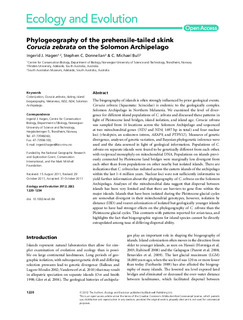| dc.contributor.author | Hagen, Ingerid Julie | |
| dc.contributor.author | Donnellan, Stephen | |
| dc.contributor.author | Bull, Michael | |
| dc.date.accessioned | 2019-10-15T07:33:09Z | |
| dc.date.available | 2019-10-15T07:33:09Z | |
| dc.date.created | 2013-01-18T11:18:58Z | |
| dc.date.issued | 2012 | |
| dc.identifier.citation | Ecology and Evolution. 2012, 2 (6), 1220-1234. | nb_NO |
| dc.identifier.issn | 2045-7758 | |
| dc.identifier.uri | http://hdl.handle.net/11250/2622135 | |
| dc.description.abstract | The biogeography of islands is often strongly influenced by prior geological events. Corucia zebrata (Squamata: Scincidae) is endemic to the geologically complex Solomon Archipelago in Northern Melanesia. We examined the level of divergence for different island populations of C. zebrata and discussed these patterns in light of Pleistocene land bridges, island isolation, and island age. Corucia zebrata was sampled from 14 locations across the Solomon Archipelago and sequenced at two mitochondrial genes (ND2 and ND4; 1697 bp in total) and four nuclear loci (rhodopsin, an unknown intron, AKAP9, and PTPN12). Measures of genetic divergence, analyses of genetic variation, and Bayesian phylogenetic inference were used and the data assessed in light of geological information. Populations of C. zebrata on separate islands were found to be genetically different from each other, with reciprocal monophyly on mitochondrial DNA. Populations on islands previously connected by Pleistocene land bridges were marginally less divergent from each other than from populations on other nearby but isolated islands. There are indications that C. zebrata has radiated across the eastern islands of the archipelago within the last 1–4 million years. Nuclear loci were not sufficiently informative to yield further information about the phylogeography of C. zebrata on the Solomon Archipelago. Analyses of the mitochondrial data suggest that dispersal between islands has been very limited and that there are barriers to gene flow within the major islands. Islands that have been isolated during the Pleistocene glacial cycles are somewhat divergent in their mitochondrial genotypes, however, isolation by distance (IBD) and recent colonization of isolated but geologically younger islands appear to have had stronger effects on the phylogeography of C. zebrata than the Pleistocene glacial cycles. This contrasts with patterns reported for avian taxa, and highlights the fact that biogeographic regions for island species cannot be directly extrapolated among taxa of differing dispersal ability. | nb_NO |
| dc.language.iso | eng | nb_NO |
| dc.publisher | Wiley Open Access | nb_NO |
| dc.rights | Navngivelse-Ikkekommersiell 4.0 Internasjonal | * |
| dc.rights.uri | http://creativecommons.org/licenses/by-nc/4.0/deed.no | * |
| dc.title | Phylogeography of the prehensile tailed skink Corucia zebrata on the Solomon Archipelago | nb_NO |
| dc.type | Journal article | nb_NO |
| dc.type | Peer reviewed | nb_NO |
| dc.description.version | publishedVersion | nb_NO |
| dc.source.pagenumber | 1220-1234 | nb_NO |
| dc.source.volume | 2 | nb_NO |
| dc.source.journal | Ecology and Evolution | nb_NO |
| dc.source.issue | 6 | nb_NO |
| dc.identifier.doi | 10.1002/ece3.84 | |
| dc.identifier.cristin | 992053 | |
| dc.description.localcode | © 2012 The Authors. Ecology and Evolution published by Blackwell Publishing Ltd. This is an open access article under the terms of the Creative Commons Attribution-NonCommercial License, which permits use, distribution and reproduction in any medium, provided the original work is properly cited and is not used for commercial purposes. | nb_NO |
| cristin.unitcode | 194,66,10,0 | |
| cristin.unitname | Institutt for biologi | |
| cristin.ispublished | true | |
| cristin.fulltext | original | |
| cristin.qualitycode | 1 | |

